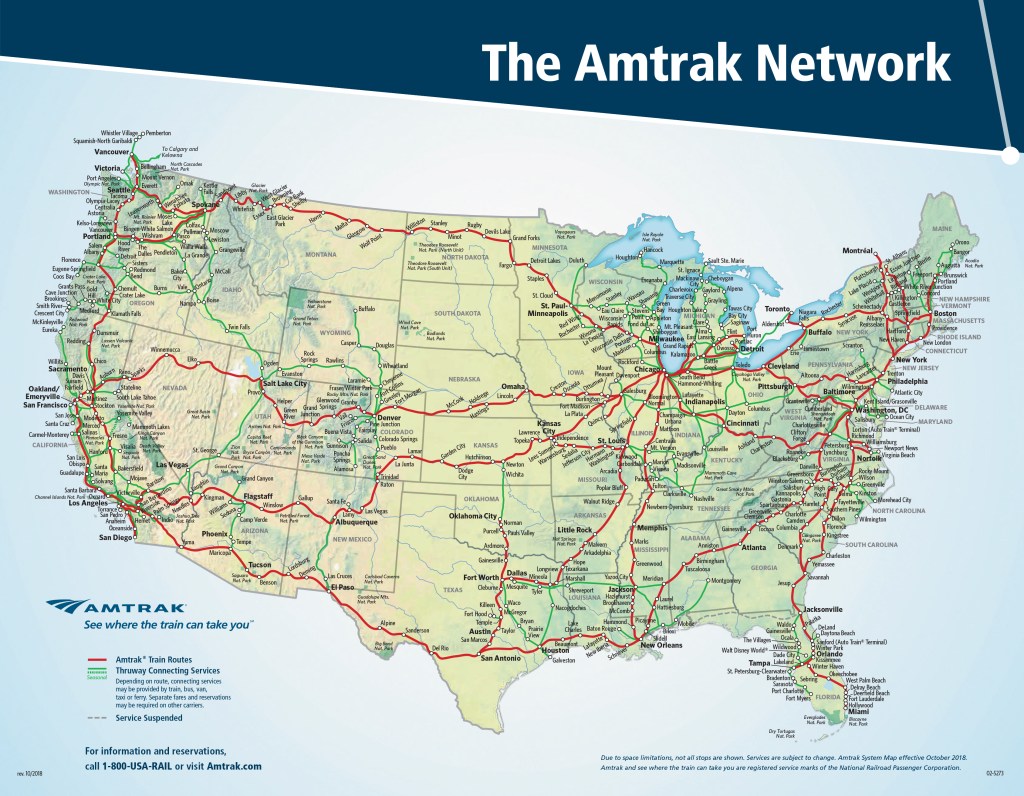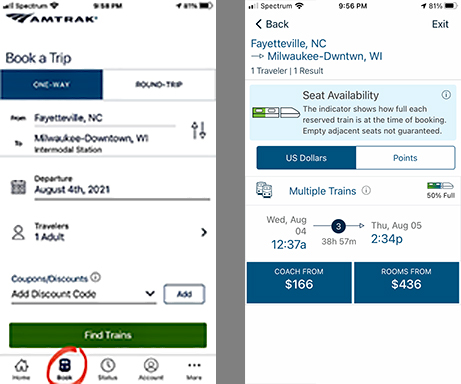The concept of the Amtrak Rail Pass is simple: for $499 (or less, if you happen to catch a sale), you get “10 rides… over 30 days to your choice of over 500 destinations.” Planning your route is slightly more complicated, but this post will give you some basic knowledge and tips that should make the process easier and help you to get the most out of your pass. Currently, I’m in the process of planning my third long trip via rail pass, and though things have changed a lot since I got my first pass in 2009, the lessons I learned on those first two trips were invaluable when it came time to plan this one.
Lesson 1: Segments and Train Routes
Amtrak refers to each of your 10 rides as a segment. Again, the concept is simple, but when you factor train routes into that concept, things become more complicated. Amtrak has more than 30 train routes, and if Point A and Point B are not on the same route, you will have to switch trains, using up multiple segments. Let’s use the trip I’m currently planning as an example.
I’ll be leaving from Fayetteville, North Carolina (my Point A). Having taken all of the other major routes in the West on previous trips (the California Zephyr, Southwest Chief, Texas Eagle, Heartland Flyer, Sunset Limited, and Coast Starlight), I have my sights set this time on the Empire Builder, a route that runs from Chicago to Portland or Seattle with many stops in between. On the map below, it’s the northernmost route across middle America:

If you’re traveling east to west, the Empire Builder route begins in Chicago, but since I have visited the Windy City many times already, I think I’ll skip it. My friend Cecy is joining me on this trip, and since she’s never been to Wisconsin, we decided we wanted to make our first stop in Milwaukee (Point B). The issue is that there is no direct Amtrak route from Fayetteville to Milwaukee, so in order to make the trip, we would have to change trains, using multiple segments.
In order to figure out how many segments you would need to travel between two destinations, you can download the Amtrak app, click the “Book” icon at the bottom of the screen, and type in your departure and arrival cities, as well as the date you want to travel. You can see that the search results below on the right indicate that you would have to take multiple trains between Fayetteville and Milwaukee, and the solid blue circle indicates the exact number of trains: in this case, 3–for a total of 3 segments. Please note that you can get the same information through the Amtrak website if you prefer websites to apps.

In the scenario outlined above, Cecy and I would have to travel from Fayetteville to Washington, D.C. on the Silver Meteor (segment 1), from Washington D.C. to Chicago on the Cardinal (segment 2), and from Chicago to Milwaukee on the Empire Builder or Hiawatha Service (segment 3). That would be great if we wanted to hop off the train and explore D.C. or Chicago, but I’ve already spent a lot of time in both cities. So that brings me to…
Lesson 2: Supplemental Forms of Transportation
Rather than eat up 3/10 segments getting from Point A to Point B, Cecy and I decided to get a couple of cheap, one-way plane tickets from North Carolina to Wisconsin. We’d gotten our rail passes on sale for $299, so the extra expenditure wasn’t prohibitive for either of us, especially considering we’d decided to save on accommodations by staying with various friends and Couchsurfing (but more on that in a later post). After much contemplation and browsing around, we decided to fly from Raleigh to Green Bay so that we could visit Door County, which I’ve been curious about ever since reading a description many years ago in John Villani’s 100 Best Small Art Towns in America. The plan is that we’ll spend a few days exploring communities along the Lake Michigan shoreline and then bus down to Milwaukee to begin traveling with our rail passes.
In addition to using supplemental forms of travel in scenarios like the one described above, you should also consider employing this method any time you’re traveling between two destinations that aren’t very far apart (e.g., Boston and New York). Keep in mind that if you pay full price for the rail pass, you’re basically paying $50 for each segment, so if you can avoid it, you don’t want to waste a segment on a short trip like Boston to New York, which right now would cost you only $29 a la carte on Amtrak and may be even more inexpensive by bus. Moreover, you don’t have to pick up where you left off, so even if segment 1 is Chicago to Boston, segment 2 can be New York to Miami.
Lesson 3: Arrival and Departure Times
When it comes to arrival and departure times, there are a couple of things you need to know: the first is that the timing of arrivals and departures may be inconvenient in some places, and the second is that for all the magical romanticism that comes along with traveling by train, delays are likely.
On a few occasions, I’ve taken the Amtrak from Fayetteville to Washington D.C. or New York City when the only available option was the Silver Meteor departing at 12:37 AM. The Palmetto is another train that travels north at more convenient times, but it sells out more quickly and experiences occasional service disruptions. I am familiar enough with Fayetteville to feel comfortable hanging out at the train station past midnight, but there have been times when 12:37 AM turned into 3:30 AM because of delays. You should also keep in mind that with the rail pass, you’re traveling in coach, and there is currently no option to upgrade to a sleeper car; the seats recline generously, but they’re not beds. I’ve figured out ways to make it work overnight (eye masks and earplugs or headphones help, for instance), but my sleep has not always been the best.
When it comes to inconvenient arrival times, I once had a trip scheduled on the Coast Starlight (perhaps the most gorgeous route I’ve taken to date) from Los Angeles to Martinez, CA (not far from San Francisco), arriving a little past 10 PM. When my Couchsurfing host in L.A. found out about the arrival time, though, he recommend that I make an earlier stop in San Jose instead. I was traveling alone, was scheduled to arrive after dark, and was unfamiliar with Martinez. I later visited the Martinez station during daylight hours and felt totally safe, but I still don’t know what it’s like after dark. In any case, I appreciated my host’s concern for my safety, took his advice, and stopped for the night in San Jose before heading up to San Francisco.
The last little snippet I’ll share happened in 2017 when I was traveling between Lawrence, Kansas and Albuquerque, New Mexico on the Sunset Limited, another gorgeous route during which a park ranger occasionally comes to the observation deck as you’re traveling through the desert to tell passengers about the cacti and whatnot. I don’t remember exactly what time I was scheduled to arrive, but I think I was something like eight hours behind schedule on account of a late departure and hot rails in the desert that made the train slow to a crawl.
My philosophy on train delays is that they keep things interesting and make me think on my feet, but if you’re not someone who enjoys modifying your plans as you go, you may want to consider another mode of transportation.
Lesson #4: Change of Plans
While train delays may occasionally force you to modify your plans, one of the lovely things about traveling with a rail pass is that Amtrak allows you to make changes to your route after you’ve booked your trip without incurring a penalty. During my trip in 2017, for instance, a couple of people I crossed paths with along my way described Pittsburgh in such a manner that made me want to drop everything and go straight to this city I’d never previously had any interest in. And I was able to do just that!
I think that technically, you are required to make the changes before the train is scheduled to depart, but I will say that in at least one instance, I was able to call customer support while I was actually on a train and modify my destination city. I don’t think it’s Amtrak’s policy to allow people to make modifications once a trip is underway, but if you have an extenuating circumstance of some kind, it’s possible that an agent could make an exception. I don’t think that goes for missed trains, though. If you miss a train and didn’t make modifications to your trip before it was scheduled to depart, it will cost you a segment.
Leave a reply to Shannon C. Ward Cancel reply